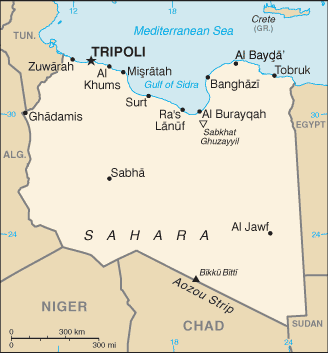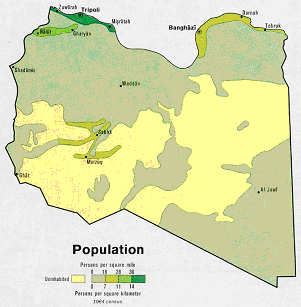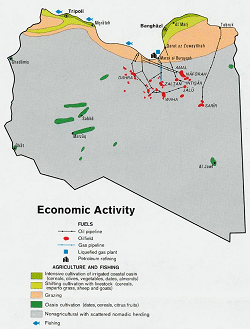|
|
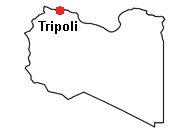 |
| |
back to top | ||
|
Cheetahs may still live around Fezzan oasis, in the south-east of the country. Cheetahs have been reported in Ghadames, Trippolin region and Fezzan (Toshi 1954, observations befor 1941). |
|||
|
|||
|
Background: The Italians supplanted the Ottoman Turks from the area around Tripoli in 1911 and did not relinquish their hold until 1943 when defeated in World War II. Libya then passed to UN administration and achieved independence in 1951. Following a 1969 military coup, Col. Muammar Abu Minyar al-QADHAFI began to espouse his own political system, the Third Universal Theory. The system is a combination of socialism and Islam derived in part from tribal practices and is supposed to be implemented by the Libyan people themselves in a unique form of "direct democracy." QADHAFI has always seen himself as a revolutionary and visionary leader. He used oil funds during the 1970s and 1980s to promote his ideology outside Libya, supporting subversives and terrorists abroad to hasten the end of Marxism and capitalism. In addition, beginning in 1973, he engaged in military operations in northern Chad's Aozou Strip - to gain access to minerals and to use as a base of influence in Chadian politics - but was forced to retreat in 1987. UN sanctions in 1992 isolated QADHAFI politically following the downing of Pan AM Flight 103 over Lockerbie, Scotland. Libyan support for terrorism appeared to have decreased after the imposition of sanctions. During the 1990s, QADHAFI also began to rebuild his relationships with Europe. UN sanctions were suspended in April 1999 and finally lifted in September 2003 after Libya resolved the Lockerbie case. In December 2003, Libya announced that it had agreed to reveal and end its programs to develop weapons of mass destruction, and QADHAFI has made significant strides in normalizing relations with western nations since then. He has received various Western European leaders as well as many working-level and commercial delegations, and made his first trip to Western Europe in 15 years when he traveled to Brussels in April 2004. QADHAFI also resolved in 2004 some of the outstanding cases against his government for terrorist activities in the 1980s by compensating some families of victims of the Pan Am 103, French airliner UTA, and La Belle disco bombings. The US resumed full diplomatic relations with Libya in May 2006 and rescinded Libya's designation as a state sponsor of terrorism in June. |
|||
| |
back to top | ||
|
|
|
|
|
|
|
|
|
|
|
Area: total: 1,759,540 sq km; land: 1,759,540 sq km; water: 0 sq km Climate: Mediterranean along coast; dry, extreme desert interior Terrain: mostly barren, flat to undulating plains, plateaus, depressions Natural resources: petroleum, natural gas, gypsum Land use: arable land: 1.03%; permanent crops: 0.19%; other: 98.78% (2005) Irrigated land: 4,700 sq km (2003) Natural hazards: hot, dry, dust-laden ghibli is a southern wind lasting one to four days in spring and fall; dust storms, sandstorms Environment - current issues: desertification; very limited natural fresh water resources; the Great Manmade River Project, the largest water development scheme in the world, is being built to bring water from large aquifers under the Sahara to coastal cities Environment - international agreements: party to: Biodiversity, Climate Change, Desertification,
Endangered Species, Hazardous Wastes, Marine Dumping, Ozone Layer Protection,
Wetlands |
|||
| |
back to top | |
|
Population: 5,900,754; note: includes 166,510 non-nationals (July 2006 est.) Age structure: 0-14 years: 33.6% (male 1,012,748/female 969,978); 15-64 years: 62.2% (male 1,891,643/female 1,778,621); 65 years and over: 4.2% (male 121,566/female 126,198) (2006 est.) Median age: total: 23 years; male: 23.1 years; female: 22.9 years (2006 est.) Population growth rate: 2.3% (2006 est.) Infant mortality rate: total: 23.71 deaths/1,000 live births; male: 25.99 deaths/1,000 live births; female: 21.32 deaths/1,000 live births (2006 est.) Life expectancy at birth: total population: 76.69 years; male: 74.46 years; female: 79.02 years (2006 est.) Total fertility rate: 3.28 children born/woman (2006 est.) HIV/AIDS - adult prevalence rate: 0.3% (2001 est.) HIV/AIDS - people living with HIV/AIDS: 10,000 (2001 est.) HIV/AIDS - deaths: NA |
|
|
|
|
|
|
| Ethnic groups: Berber and
Arab 97%, Greeks, Maltese, Italians, Egyptians, Pakistanis, Turks, Indians,
Tunisians Religions: Sunni Muslim 97% Languages: Arabic, Italian, English, all are widely understood in the major cities Literacy: definition: age 15 and over can read and write; total population: 82.6%; male: 92.4%; female: 72% (2003 est.) |
|
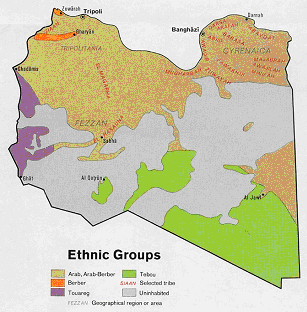 |
| |
back to top |
|
Data Code: LY Government type: Jamahiriya (a state of the masses) in theory, governed by the populace through local councils; in practice, an authoritarian state Independence: 24 December 1951 (from UN trusteeship) Legal system: based on Italian civil law system and Islamic law; separate religious courts; no constitutional provision for judicial review of legislative acts; has not accepted compulsory ICJ jurisdiction Political pressure groups and leaders: various Arab nationalist movements with almost negligible memberships may be functioning clandestinely, as well as some Islamic elements; an anti-QADHAFI Libyan exile movement exists, primarily based in London, but has little influence |
|
| |
back to top |
|
|
Economy - overview: The Libyan economy depends primarily upon revenues from the oil sector, which contribute about 95% of export earnings, about one-quarter of GDP, and 60% of public sector wages. Substantial revenues from the energy sector coupled with a small population give Libya one of the highest per capita GDPs in Africa, but little of this income flows down to the lower orders of society. Libyan officials in the past four years have made progress on economic reforms as part of a broader campaign to reintegrate the country into the international fold. This effort picked up steam after UN sanctions were lifted in September 2003 and as Libya announced in December 2003 that it would abandon programs to build weapons of mass destruction. Almost all US unilateral sanctions against Libya were removed in April 2004, helping Libya attract more foreign direct investment, mostly in the energy sector. Libyan oil and gas licensing rounds continue to draw high international interest. Libya faces a long road ahead in liberalizing the socialist-oriented economy, but initial steps - including applying for WTO membership, reducing some subsidies, and announcing plans for privatization - are laying the groundwork for a transition to a more market-based economy. The non-oil manufacturing and construction sectors, which account for more than 20% of GDP, have expanded from processing mostly agricultural products to include the production of petrochemicals, iron, steel, and aluminum. Climatic conditions and poor soils severely limit agricultural output, and Libya imports about 75% of its food. |
|
The non-oil manufacturing and construction sectors, which account for more than 20% of GDP, have expanded from processing mostly agricultural products to include the production of petrochemicals, iron, steel, and aluminum. Climatic conditions and poor soils severely limit agricultural output, and Libya imports about 75% of its food. |
|
|
|
|
|
GDP - real growth rate: 8.1% (2006 est.) GDP - composition by sector: agriculture: 7.3%; industry: 51.3%; services: 41.4% (2006 est.) Labor force: 1.787 million (2006 est.) Labor force - by occupation: agriculture: 17%; industry: 23%; services: 59% (2004 est.) Unemployment rate: 30% (2004 est.) Population below poverty line: 7.4% Agriculture - products: wheat, barley, olives, dates, citrus, vegetables, peanuts, soybeans; cattle Industries: petroleum, iron and steel, food processing, textiles, handicrafts, cement Industrial production growth rate: NA% Exports: $37.02 billion f.o.b. (2006 est.) Exports - commodities: crude oil, refined petroleum products, natural gas, chemicals Exports - partners: Italy 37.7%, Germany 15.1%, Spain 9.3%, Turkey 6.2%, France 6.2%, US 5.2% (2005) Imports: $14.47 billion f.o.b. (2006 est.) Imports - commodities: machinery, semi-finished goods, food, transport equipment, consumer products Imports - partners: Italy 21.2%, Germany 10.3%, Tunisia 5.6%, Turkey 4.8%, UK 4.8%, France 4.7%, South Korea 4.6%, China 4.5% (2005) Currency (code): Libyan dinar (LYD) Exchange rates: Libyan dinars per US dollar - 1.315 (2006), 1.3084 (2005), 1.305 (2004), 1.2929 (2003), 1.2707 (2002) |
|
| back to top | |
|
Telephone system: general assessment: telecommunications system is being modernized; mobile cellular telephone system became operational in 1996; domestic: microwave radio relay, coaxial cable, cellular, tropospheric scatter, and a domestic satellite system with 14 earth stations; international: country code - 218; satellite earth stations - 4 Intelsat, NA Arabsat, and NA Intersputnik; submarine cables to France and Italy; microwave radio relay to Tunisia and Egypt; tropospheric scatter to Greece; participant in Medarabtel (1999) Radio broadcast stations: AM 16, FM 3, shortwave 3 (2002) Television broadcast stations: 12 (plus one low-power repeater) (1999) Internet country code: .ly Internet hosts: 31 (2006) Internet users: 205,000 (2005) |
|
| back to top |
|
O’Mopsan
L.K.1998. The 1996 International Cheetah Studbook - an updated status report http://www.lib.utexas.edu/maps/libya.html |


